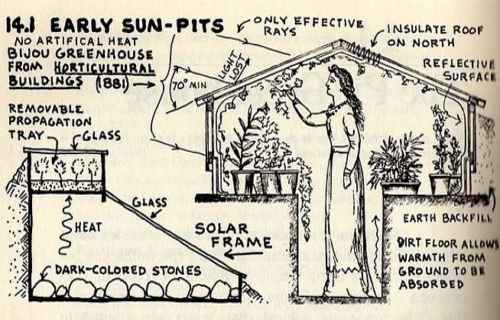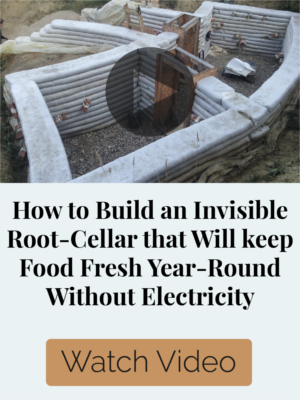
We use cellars because they maintain a more constant temperature than structures that are built above-ground. We use greenhouses to extend the growing season because they hold in heat. Well what if you combined a greenhouse and a cellar? You’d have a greenhouse that would allow you to grow plants year-round.
This type of greenhouse is called a geothermal, pit or, Walipini greenhouse, and is common in South America. ‘Walipini’ means ‘place of warmth’ in Aymara Indian, and it’s an apt name.
Basically, the idea is that once you get below the frost line (3-5 feet below the surface, the Earth maintains a fairly constant temperature. In the US, that temperature is typically around 45-50 degrees in the northern states and 50-70 in the south. That range makes for perfect plant-growing temperatures, especially when you add a covering to one side that sun can shine through and warm it up a bit.
You’re harnessing the existing geothermal heat by digging 6-8 feet underground and capturing and storing solar radiation in order to create a near-ideal growing climate that’s resistant to surface-level temperature changes.
Benefits of a Walipini Greenhouse
There’s the most obvious benefit – you extend your growing season, or even make it so that you can grow food year-round.
Another reason that this type of greenhouse may appeal to preppers is that, depending on how you build it, it’s not obvious what’s in it so your food will be better hidden.
I’ve even seen articles about Walipinis that are built in such a way that they are a self-sustaining unit containing animals, aquaculture, and hydroponic plants. That’s a bit complicated and beyond the scope of what we’re doing today, but it can be done.
If you live in a dry climate, another advantage is that your Walipini is going to hold moisture from the ground in. You can help this along by using water along the wall to help pull the heat from the earth. That way, you’re making the air warmer and moister. Plants will love you. Actually, take condensation into consideration when you’re building.
The final advantage that a Walipini or pit greenhouse has is that you can build the whole thing for just a few hundred bucks. Less if you already have the materials.
Learn from our ancestors the old lessons of growing your own food.
How to Situate your Walipini Greenhouse
The first thing you need to do before you start gathering materials is determine where you’re going to build. You need to know a couple of things when you make this decision:
- your local water table
- how large you want your greenhouse to be. The larger it is, the more stable the temperature will be.
Ideally, a Walipini greenhouse is built by digging into the ground so that 3 sides and the floor are underground, and the exposed side, which is covered with windows or plastic, is built facing the winter sun – south in the northern hemisphere – and at a 90-degree angle to the sun. Think digging into a hillside, then covering the hole with plastic, which is actually a pretty good description.
Of course, what’s ideal isn’t always realistic. We don’t all live in places that even have hills to dig into. You can also dig them so that they’re just a pit and the sun is directly overhead. Of course, you’ll see that you can use the dirt that you remove from the pit to build up the rear side of the pit both for better insulation and to give you that angle for your plastic that will both help with rain run-off and position your light better.
The important things are that you dig beyond the frost-line, provide good insulation that will pull the heat in, and make sure that you don’t dig below the water line. Obviously, that would be bad. You need to make sure that the floor will be at least 4 feet above the water line.
Now, if you live in an area where the water table is measured in inches instead of feet, (many coastal areas) that doesn’t mean that you can’t build this – it just means that you need to be a bit more creative and that most of your structure will be above ground and you’ll pile dirt around it.
Video first seen on Ben Green.
What do you Need to Build a Walipini Greenhouse?
At its most basic, all that’s needed is (maybe) wooden support beams (2x4s or poles), greenhouse plastic or windows, and insulating materials – natural soil may be used for the walls if it’s structurally sound enough to hold up – such as clay or mud bricks, clay, straw bales, earth bags, concrete, cinderblocks, or stone. Of course, you’ll need nails or screws for the support beams, and a door and door frame.
Digging out your Walipini
When you start to dig, save the topsoil to use as the soil in the floor of your Walipini because the sub-soil won’t be good for growing. You can use the remaining dirt that you remove to build up the back berm of the structure so that you have better insulation and a higher back wall.
Many people dig a drainage ditch around the Walipini to help the water flow around the greenhouse instead of into it.
Dig down at least 6 feet (8 or 10 feet is even better) as long as you’re maintaining your distance from the water line. If you’re building into a hillside, you’re literally going to scoop a section out of the hill so that the back wall is vertical and the floor is horizontal.
If you’re building a pit, pile the soil that you’re removing so that it creates a berm behind and on the north side of the hole.
Remember when you’re digging that you’re going to be insulating the walls and floor so you’ll be adding at least a foot or so back to what you’re digging out. Account for that when you’re designing it.
There are so many different ways to design your Walipini based on your needs and geography that telling you where to put the door wouldn’t be of much help; just remember not to build one into your plans when you’re designing the Walipini.
Once you have your whole dug, reinforce your north, east, and west walls with whatever you chose as your insulator. Natural stone and brick are both great choices because they naturally pull the heat (and moisture) from the ground and into the greenhouse. Some people choose to line the floors with stones and some don’t.
Now, you have to decide if you’re going to plant directly into the floor or are you going to treat this as a standard greenhouse and use containers? I also saw a few great examples of container garden-type methods.
Ted’s Woodworking offers a comprehensive guide with more than 16,000 plans as well as projects for woodworking. The step-by-step plan guide leaves nothing to doubt with the most comprehensive woodwork information you will find. These instructions help you to finish the job in a thorough manner. while you might never have considered building a particular piece of furniture. Ted’s Woodworking offers the ability of a complete woodworking plan so that you can accomplish it. Other projects that might be of interest include dog houses, bird feeders, garden chairs, children’s room projects, sheds and media center plans.
If you’re planting straight onto the floor, it’s a good idea to put a layer of gravel 6 or 8 inches deep under the soil to help with drainage and to pull more heat up from the ground. You can use compost or manure under the topsoil because it naturally generates heat as it decomposes and will help warm things up.
After you get your walls built, it’s time to cover the pit. I’ve seen several examples where people built a vent into the roof in order to let some of the heat escape. This may sound silly, but the inside of a Walipini can be as high as 100 degrees even in its below freezing outside – that’s no exaggeration.
So, either build in a vent or be prepared to leave the door open or cracked for part of the day in case it does get too hot.
The roof (cover) doesn’t have to be fancy. It can be clear plastic stapled over a wooden frame with braces every few feet.
There you have it – the basics on how to build a Walipini greenhouse. It’s a simple yet effective method to help grow plants during the winter or even in climates that aren’t typically conducive to gardening at all.
Click the banner below to discover the long forgotten secrets that helped our forefathers survive during harsh times!
Do you have a Walipini or pit greenhouse? If so, please share your ideas and experiences with us in the comments section below. Also, feel free to ask questions.
When the power goes out, your safety and comfort is important.
Protect your home or business with a new fully automatic standby generator. Maintain your security system, lighting and air conditioning to keep your family or business safe and comfortable through any power outage
Enjoy the total peace of mind that comes with knowing you have a constant and reliable power supply for your home or business in with a standby generator from Alternate Power Solutions. From everyday necessities like heating, cooling, refrigeration and lights, to daily essentials like cooking, laundry or kids bath times. Power outages are occurring more frequently than ever and lasting longer with devastating effects.
Stand up to unpredictable weather and unforeseen outages with the most trusted name in residential standby power with backup generators for homes. If the power ever goes out, your General standby generator goes on – automatically – protecting you and your home 24/7.
Books can be your best pre-collapse investment.
Carnivore’s Bible (is a wellknown meat processor providing custom meat processing services locally andacross the state of Montana and more. Whether your needs are for domestic meator wild game meat processing)
The Lost Book of Remedies PDF ( contains a series of medicinal andherbal recipes to make home made remedies from medicinal plants and herbs.Chromic diseases and maladies can be overcome by taking the remediesoutlined in this book. The writer claims that his grandfather was taughtherbalism and healing whilst in active service during world war twoand that he has treated many soldiers with his home made cures. )
Easy Cellar(Info about building and managing your root cellar, plus printable plans. The book on building and using root cellars – The Complete Root Cellar Book.)
The Lost Ways (Learn the long forgotten secrets that helped our forefathers survive famines,wars,economic crisis and anything else life threw at them)
LOST WAYS 2 ( Wordof the day: Prepare! And do it the old fashion way, like our fore-fathers did it and succeed longbefore us,because what lies ahead of us will require all the help we can get. Watch this video and learn the 3 skills that ensured our ancestors survival in hard times offamine and war.)
The Lost Book of Remedies PDF ( contains a series of medicinal andherbal recipes to make home made remedies from medicinal plants and herbs.Chromic diseases and maladies can be overcome by taking the remediesoutlined in this book. The writer claims that his grandfather was taughtherbalism and healing whilst in active service during world war twoand that he has treated many soldiers with his home made cures. )
This article has been written by Theresa Crouse for Survivopedia.



